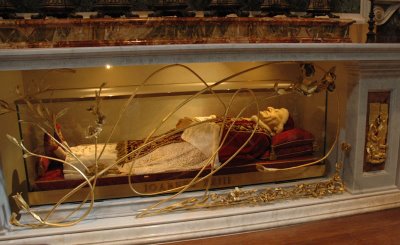It wasn't his fault
 The Question of Incorruptibility by Fr. William Saunders
The Question of Incorruptibility by Fr. William Saunders
When the inner casket was opened, Cardinal Noe said that the face of Blessed Pope John XXIII appeared "intact and serene." The official report stated, "Once freed from the cloth that covered it, the face of the blessed appeared intact, with the eyes closed and the mouth slightly open, and bearing the features that immediately called to mind that familiar appearance of the venerated pontiff." The pope’s hands, still holding a cross, were also preserved.
While trying to avoid any sense of the macabre, such an investigation is integral to the canonization process. Prospero Cardinal Lambertini (later Pope Benedict XIV, 1675-1758) wrote a five-volume work entitled De Beatificatione Servorum Dei et de Beatorum Canonizatione in which he included the chapter De Cadaverum Incorruptione. This work remains the classic reference for such matters. The only incorrupt remains considered extraordinary and thereby miraculous would be those which had not undergone some preservation process but had retained their lifelike color, freshness and flexibility for many years after death. Spiritually, such a sign is indicative of the person’s mortal remains being prepared for the glorious resurrection of the body. Although the Church is very reluctant to accept incorruptibility as a miracle in itself, it nevertheless does testify to the holiness of the person.
In weighing these phenomena, other mitigating factors must be taken into account. For instance, the body of Blessed Pope John XXIII was kept in a marble sarcophagus that contained three caskets — one of oak, one of lead and one of cypress. Although the body had not been embalmed, it had been sprayed with some chemicals so that it could be displayed prior to burial. Nazareno Gabrielli, a technician with the Vatican Museums, stated, "When he died, some measures were taken for the display of the body for the veneration of the faithful. It also should not be forgotten that the remains were kept in three caskets, one of which was sealed lead." Therefore, probably little oxygen penetrated the caskets and affected the remains. (After the body was officially recognized, it was sprayed with an anti-bacterial agent, and the casket was hermetically sealed.)
In all, incorruptibility remains a sign of the holiness of the life of the individual. The bodies of

0 Comments:
Post a Comment
<< Home